Guide To Fishing For Other Freshwater Fish Species
By Rick Seaman
Last updated on .
Explore the world of fishing for muskie and tiger muskie, northern pike, alligator gar, bowfin, chain pickerel, longnose gar, paddlefish, spotted gar and sturgeon. Each species offers its own unique challenge and allure. Begin by selecting a state to discover lakes where these species thrive.
Although these fish may not enjoy the same widespread popularity as some of the primary species featured on this website, they possess a distinct appeal for anglers seeking diverse and specialized fishing experiences. Their distribution often corresponds to specific geographic regions, influenced by factors such as water temperatures, weather patterns, and habitat preferences. As a result, anglers may need to tailor their fishing strategies and travel plans accordingly to target these species successfully. Whether you're drawn to the brute strength of a northern pike or the prehistoric allure of a sturgeon, each of these unique fish offers a rewarding challenge.
Fishing For Unique Fish Species
Fishing For Alligator Gar
Lepisosteus spatula
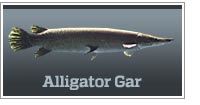
Of all the gar species, the alligator gar is the largest. Ideal water temperature: 65° to 78°
World record: 279 pounds
Found in lakes and waterways in the southeast United States, it is also the largest exclusively freshwater fish found in the United States. Mature alligator gar can top 300 pounds and exceed ten feet in length. This predator will eat most anything that moves including fish, waterfowl, frogs, alligators and other creatures found inhabiting its world. Most common methods for catching include trot lines, live bait and bow fishing. Prefers warm water temperatures. Also known as gar, garfish and gatergar.
Fishing For Bowfin
Amia calva
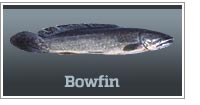
The bowfin is also known as dogfish, mud pike, mudfish, grindle and swamp bass. Ideal water temperature: 68° to 82°
World record: 21 pounds, 8 ounces
Found in waters around Alabama, Florida, Louisiana and Mississippi, the bowfin prefers water temperatures of the warmer climates. It has an exceptionally long dorsal fin which extends back to the tail, made of about 50 spines or rays. Near the upper tail is an eye spot. They have very sharp teeth and a nasty disposition when hooked. Handle with caution. They are most often caught on cut bait and crayfish. They put up quite a fight and are not considered good eating.
Fishing For Chain Pickerel

Esox niger
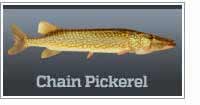
Also known as pickerel, eastern pickerel, pike, grass pike, jackfish, jack and others. Ideal water temperature: 62° to 70°
World record: 9 pounds, 6 ounces
A freshwater fish in the pike family easily identified by the "chain-like marking along its sides. It can be found in the northwest, northeast and southeast sections of the USA. Its primary food source is smaller fish and is known to lie in wait to ambush its prey. While it can be eaten it is not considered one of the better sport fishes for table fare. Chain pickerel can be caught on fish-imitation lures and live or cut bait. Watch the sharp teeth when handling.
Fishing For Longnose Gar
Lepisosteus osseus
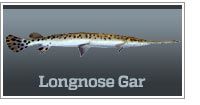
Also referred to as gar and garfish, It has a long, sword-like mouth loaded with sharp teeth. Ideal water temperature: 65° to 80°
World record: 25 pounds, 0 ounces
The Longnose Gar can be found in lakes and rivers and prefers quiet backwaters with warmer temperatures. They are nocturnal feeders and eat most smaller fish. They can be taken on live bait, fish-imitating lures and nylon string "gobs designed to entangle in their teeth. Most longnose gar are taken by bow fishing or spear fishing. The meat is somewhat tasty but quite bony.
Fishing For Muskie - Muskellunge

Esox masquinongy

The largest of the pike family, they are found in about half the states. Ideal water temperature: 55° to 70°
World record: 67 pounds, 8 ounces
Muskie are found primarily the northern and northeastern states. They prefer clear water lakes and streams. Also known as musky, muskie and great pike, they eat any fish they can catch and prefer to ambush their prey. They also eat crayfish, frogs and birds.Use large lures (salt-water sizes) and heavy line when fishing for muskellunge. They are known for their speed and are exceptionally strong for short runs. They will hit large musky lures and fresh cut bait.
Fishing For Northern Pike

Esox Lucius

Also known as jack, jackfish, great northern pike and pickerel. Ideal water temperature: 58° to 70°
IFGA record: 55 pounds, 1 ounce
The northern pike is a valiant fighter and prefers cool water temperatures. While they have been transplanted into most states with cold water, they are native to the northern states and are abundant in the northeastern states. Northern pike are basically olive in color with white and/or yellow bellies. The northern pike has light-colored marking on a dark body whish is opposite that of their cousins the muskies.They are an ambushing predator that eats frogs, crayfish, birds and virtually any fish they can get into their mouth. When fishing for northern pike use bright colored northern pike lures including spinners, fish-imitating lures, jerk-baits or cut bait and concentrate your fishing close to cover.
Fishing For Paddlefish
Polyodon spathula

Also known as spoonbill, spoonies, spadefish and shovelnose. Ideal water temperature: 50° to 70°
Rod and reel world record: 144 pounds
If you didn't know what they were, you might think you caught a shark if you were to land a paddlefish. They have a powerful, sleek body and a tall, rear dorsal fin. They are filter-feeders so catching them with conventional tackle is out of the question. Most are taken with bow and arrow, spears or by snag-fishing with large treble hooks.
Fishing For Spotted Gar
Lepisosteus oculatus

Most spotted gar are taken by bow fishing or spear fishing. Ideal water temperature: 63° to 78°
World record: 9 pounds, 12 ounces
Its range covers the northeast and into the southeast areas of the United States. It prefers quiet, clear water and backwaters, slow-moving creeks, rivers and sloughs. Named for the dark spots that cover its light-colored body, the spotted gar is a predator feeding on various kinds of fishes, frogs and crustaceans. Like most gar they are hard to catch on hook and line. The best method is live minnows or other small fish.
Fishing For Sturgeon
Acipenseridae
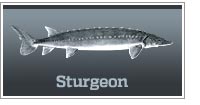
There are over 20 species commonly referred to as sturgeon Ideal water temperature: 55° to 60°
Largest caught is estimated at 1,100 pounds
Sturgeon have been captured weighing over 2,000 lbs at length in excess of 18 feet. They have been reported by divers to exist on the Columbia River up to 30-foot long. They are a prehistoric fish and have an exceptionally long life for a fish, commonly reaching sexual maturity at the age of 120 years. They are not sought for their meat, it's their egg roe which is made into caviar. They are found in major rivers feeding into the ocean and can be caught with cut bait, giant hooks, heavy weights and stout line. The larger ones can fight an angler for days and not tire out.
Fishing For Tiger Muskie - Muskellunge

Esox lucius ~ Esox masquinongy

The tiger muskellunge is a cross of the musky and northern pike. Ideal water temperature: 58° to 70°
USA record: 51 pounds, 3 ounces
Male tiger muskellunge are most often sterile yet some females are fertile. Tiger muskies tend to be smaller than non-hybrid muskies but grow very fast. The body is often quite silvery with brownish fins and tail, without spots but displays broken vertical markings. Like their parent, they eat any fish they can catch and prefer to ambush their prey. They also eat crayfish, frogs and birds. Use large lures and stout line when fishing for tiger muskellunge. They will hit lures and fresh cut bait. They are known for their speed and are exceptionally strong for short runs. Tiger muskie typically inhabit swallow areas of lakes and rivers, hanging around outside weed edges and under cover of submerged vegetation. During the summer, when water temperatures warm, large tiger muskies move to cooler and hold on structure. If natural springs are present they are inclined to stay near this cooler water.
Related Articles
There are other, even less common species of fish, throughout the United States. Most of them experience very little angler attention.
Fishing for other fish, by state
090325
Miscellaneous Species Fishing Information
Fishing Information


